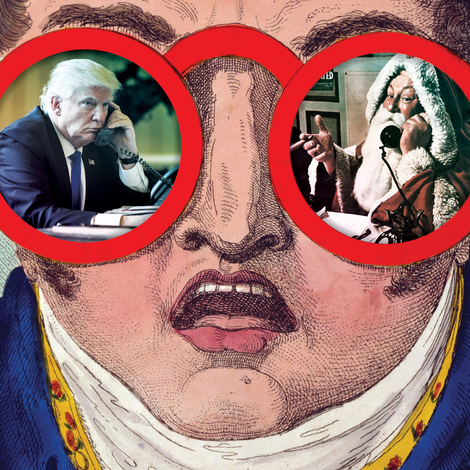American presidents traditionally favor low-key interior decoration, tending to follow George Washington, who advocated ‘a plain and neat manner, not by any means in an extravagant style’.
Of course, successive presidents add their own touches to the White House. President Kennedy, a former naval officer, decorated the Oval Office walls with seascapes, and President Obama displayed indigenous ceramics.
To emphasize his rural roots, President Carter decorated one wall of a guest room in the White House with planks from a barn owned by his wife’s grandfather.
But President Trump doesn’t have the Founding Fathers’ faith in the virtue of modesty. Though he has only been in the White House for a few months, he has already adopted the flashy, gold, porn-baron, casino style pioneered by Liberace, Imelda Marcos and King Midas.
The Oval Office coffee table sports a large golden paperweight, embossed with Trump’s name. His desk holds a box of marker pens decorated with his crazily jagged signature embossed in gold. Behind the desk is a gold statue of a basket held up by the Three Graces.
The Oval Office is now stuffed with military flags and baroque mirrors in gold frames. A Washington Post reporter noted gold angels in the pediments and a gilded floral wall trim, which apparently ‘bears an uncanny resemblance to decorative pieces sold on Alibaba for $1 to $5 apiece - made in China’.
Trump shares his taste for over-the-top interior decor with some prominent leaders, among them Saddam Hussein, Idi Amin and Nicolae Ceauşescu.
In his compelling picture-book, Dictators’ Homes (2005), the acute style guru Peter York identifies the elements these homes have in common, of which fancy, faux, French gold-work - what Nicky Haslam calls ‘Louis-the-Hotel’ - is the most glaringly obvious. ‘Gold is good and gold taps are everywhere,’ notes York. He points out that Saddam’s 65 palaces had a disproportionate number of basins in their bathrooms. ‘Gold taps say, “I’ve got money and I don’t care what people think”.’
Another characteristic of dictatorial home decor identified by York is the propensity to hang portraits of oneself everywhere. Near the entrance of the Oval Office, Trump has a framed copy of his police photograph on the cover of the New York Post.
His penthouse at Trump Tower in New York has a gold-and-diamond front door. Inside, there is marble on the floors and walls.
The only relief from all this marble is gold: Gold-rimmed chairs carry gold-rimmed cushions embroidered with the Trump coat of arms. Gold-rimmed glasses sit on a gold tray on a marble table. Gold lamps, vases and cherubs abound.
The effect is the opposite of cozy: It is impossible to imagine anyone feeling at ease in these shiny, shouty surroundings.
Poor little Vladimir Putin seems dwarfed by the absurdly oversized rooms of the Kremlin, and the tennis court-sized table at which he sits to negotiate. Trump favors XL tables, too: The marble dining table at his Florida mansion, Mar-A-Lago, is 29ft.
These items are designed to intimidate others, but can also intimidate their owners. Perhaps that is why, in photographs, Trump is hunched forward in his chair, as though preparing to run away.
Vast chandeliers hang from the ceiling in Trump’s penthouse, as they do at Mar-A-Lago. He has these chandeliers in common with a number of discredited presidents from other countries. US satirist P.J. O’Rourke noted that ‘Saddam’s chandelier was the size of a two-car garage. If a reason to invade Iraq was wanted, felony interior decorating would have done’.
York believes brash leaders like Trump got their taste in interior decoration - the ‘Ferrero Rocher look’ - from glitzy hotels, having spent a lot of time waiting in lobbies to schmooze potential backers. ‘For ambitious lads … the local grand hotel was always the good-life template.’
Craig Brown has written the Private Eye satirical diary for more than 30 years and is the author of 150 Glimpses of the Beatles and Q: A Voyage Around the Queen












